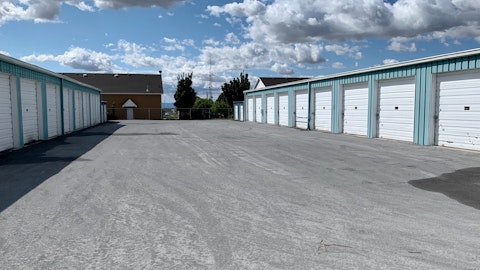Joseph Margolis: So I think we have a significant opportunity to exceed the G&A synergy of $23 million. Our original guidance for that was $140 million. Our original Extra Space guidance at the beginning of the year before this merger was contemplated. Our current midpoint guidance for G&A is $150 million. So it’s not quite $10 million every 6 months of additional G&A because we closed the merger on July 20. G&A is not smooth. G&A is higher in the first quarter. It’s not perfectly spread out through the 4 quarters. And we still have some hiring to do to fill in some spots. But clearly, we’re going to be ahead of our $23 million run rate.
Unidentified Analyst: And then on the tenant insurance synergies, how much more upside do you see there? And can you — as you continue to transition the LSI customer to [indiscernible] policy and pricing?
Joseph Margolis: So we’ve achieved very little of that synergy because the only extra space tenant insurance policies, we’re selling now are to new customers. Existing customers will not convert from the Life Storage insurance policy to the Extra Space insurance policy until starting January 1 of 2024, and that was for both regulatory and contractual reasons. But that will be somewhat of a light switch, right? We’ll send out the notice, people get them and beyond the extra space policy, which is more robust in terms of coverage but also has a higher premium.
Operator: Our next question comes from Juan Sanabria with BMO Capital Markets.
Juan Sanabria: Just wanted to kind of piggyback on a couple of questions that have already been asked. I guess on the sequential deceleration that it moderated in the third quarter, it’s expected to moderate even further. Should we think that, that continues into 2024 as you stand here today based on what you know and I’m not asking you to give 24 guidance. But I guess what the market is really wondering is have we passed the worst particularly given where comps are as we look into ’24. Just curious on your thoughts on what you could share there.
Scott Stubbs: Okay. If you look at our deceleration through the year, I mean we’ve clearly moderated that deceleration. Our fourth quarter guidance implies that it continues fairly flat from where we are today. 2024 will be ready, obviously, to give the full year guidance in February. But I think we’re set up to be — we’re in a good spot. We’d like to see new customer rates get stronger, but existing customers are holding up very well. In 2024 also has easier comps compared to what we had this year.
Juan Sanabria: And then can I just ask on the LSI occupancy front is part of the synergies that you guys are assuming that you’re able to make up the difference in occupancy between the EXR and LSI portfolio? And I guess — if so, what does that entail doing to close that gap? Or are you happy keeping the portfolio is running at different occupancy levels. Just curious on how that should evolve.
Joseph Margolis: So I’ll tell you how we underwrote the transaction to get to underwritten synergies and really how we get there, mix of occupancy and revenue, we don’t really care as much as long as we get the dollars. So at underwriting, we observed on average a 2% gap in occupancy and about a 15% gap in rate and to get to our $65 million of property synergies, we underwrote 0 improvement in occupancy and about a 7% improvement in rate. So our opportunity to do better is to achieve better than those assumptions. Sorry for [indiscernible] audience.
Juan Sanabria: I guess this is a quick. So would you want to discount further at LSI to close that gap? Or are you happy kind of running two different occupancies across the different portfolios [Technical Difficulty].
Jeffrey Norman: Thank you, everybody, for your patience. One, I’m not sure where you lost a in the middle of Joe’s response. Could you give us a reprompting before we answer the question?
Juan Sanabria: Sure. My addendum was is the goal to close eventually that occupancy gap? Or are you happy, I guess, running different levels of occupancy across the 2 portfolios?
Joseph Margolis: So the portfolios will be run on the same platform, right, despite the 2 brands, it’s going to be the same customer acquisition systems, the same pricing algorithms, the same sales process. So eventually, the two portfolio should run very similarly. We don’t have a strategy of running a higher occupancy, Extra Space store and a lower occupancy Life Storage store. Everything is going to be run on one platform to maximize revenue.
Operator: Our next question comes from Spenser Allaway from Green Street.
Spenser Allaway: I know you commented in your opening remarks that you’re focused on your asset-light initiatives right now. But can you just walk through where you’re seeing specifically the best returns in terms of your use of capital right now?
Joseph Margolis: So the best returns on capital continues to be a redevelopment of existing stores. Those returns are high single, low double-digit returns. You can add units where you already own the land, you already have the office, you already have entitlements and we are very excited to now have 1,200 more stores to look at and try to find additional opportunities to put storage in parking lots or make single stores storage, multistory storage. The challenge with those are they’re relatively small in terms of dollar investment, so you have to do a lot of them, but we have a team and a process and a program and we expect to do a lot more of those in the future. Another bridge loan program also provides very high return on capital.
The whole note rate is 10% now, average is 10% now. And when we sell the A note, the rate on the B notes is into the teens and that does not include the economic benefit of managing the property, which we lend on. So that also is a very good use of capital, particularly because we can control the capital by selling or not selling the A note.
Spenser Allaway: And then do you have a sense for ESR assets that are now in a competing radius of newly acquired LSI assets, you have a sense of what the average delta would be for the in-place rents for the EXR versus the legacy LSI assets?
Joseph Margolis: So I think our best sense is one of the ways we underwrote this transaction is. We identified 106 or 109 LSI stores that had one or more extra space store that was in a very tight geographical radius was a similar type store in terms of single-story drive-up or multistory and we felt was a truly competitive store. And at the time of underwriting, the delta in rate was about 15% for those stores.
Operator: Our next question comes from Smedes Rose from Citi.
Smedes Rose: I just wanted to ask you on the LSI portfolio, you mentioned a number of catch-up options. And just it I guess, a little less familiar with that. I’m just wondering, is that a significant part of the portfolio? Will that make a significant difference, I guess, as those customers are, I guess, cleared out who are nonpaying and putting in new customers?
Joseph Margolis: I mean it’s a standard practice when we buy a store not to rely on the prior owner’s auction process because we don’t caught up in a noncompliant auction. So we start the auction process over again, and that leads to a several month lag. So we have several months of units, nonpaying units, we have to auction out, recover those units, and we let them. It it’s temporary and in the overall scheme of things, I think not significant, although it does provide some occupancy pressure in the short run.





